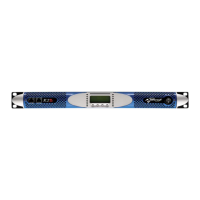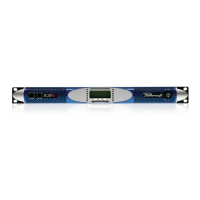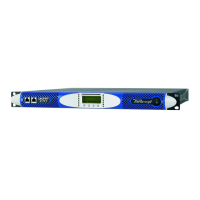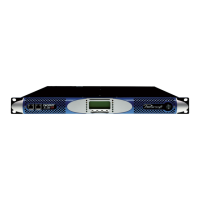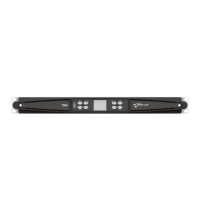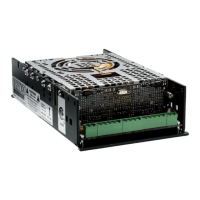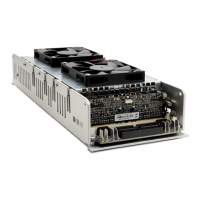AES3-A stream
Control data stream
Port 1
(master)
Port 2
(master)
Port 3
(slave)
Port 4
(slave)
Ethernet switch
FIGURE 47: Forward to AES3-A signal path. No AES3-B stream
present
This gure, on the other hand, illustrates the signal path in
“Forward to AES3-A” mode when an AES3-B stream is present;
the AES3-B stream is, in this example, incoming through master
port 1. The AES3-A stream, if present will be repeated from/to
master RJ45 ports 1 and 2.
AES3-A stream
AES3-B stream
Control data stream
Port 1
(master)
Port 2
(master)
Port 3
(slave)
Port 4
(slave)
Ethernet switch
FIGURE 48: Forward to AES3-A signal path and simultaneous AES3-B
stream in repeater mode.
▶
Forward to AES3-B:
the amplier behaves just as in the “forward to AES3-A” mode
but with respect to the AES3-B stream. The AES3 stream coming
from the rear panel XLR connector will be routed to the AES3-B
stream on both RJ45 ports 1 and 2. The AES3-A stream, if present
will be repeated from/to master RJ45 ports 1 and 2.
AES3-B stream
Control data stream
Port 1
(master)
Port 2
(master)
Port 3
(slave)
Port 4
(slave)
Ethernet switch
FIGURE 49: Forward to AES3-B signal path. No AES3-A stream
present
AES3-A stream
AES3-B stream
Control data stream
Port 1
(master)
Port 2
(master)
Port 3
(slave)
Port 4
(slave)
Ethernet switch
FIGURE 50: Forward to AES3-B signal path and simultaneous AES3-A
stream in repeater mode.
▶
Forward to both:
the amplier’s rear panel AES input via the XLR connector will be
routed to both AES3 stream A and AES3 stream B on both main
ports 1 and 2. Repeater functionality will be disabled.

